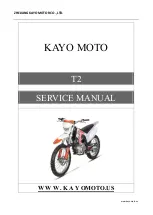
C. Valve, valve guide and valve seat
1. Valve guide
a. If the valve guide inside diameter is be-
yond serviceable limits, replace with an
oversize valve guide.
Standard
Guide diameter 8.010 8.019 mm
(I.D.)
(0.315 0.316 in)
b. Measuring the clearance between valve
and valve guide.
1)
Insert the valve into the valve guide in
the cylinder head and measure the
clearance in both the X and Y axes,
using a small dial gauge.
1. Dial gauge
2. 10 mm
i n )
2) If the measured clearance is greater
than 0.10 mm (0.0039 in) for the
inlet valve or 0.12 mm (0.0047 in) for
the exhaust valve, both the valve and
valve guide should be replaced. The
replacement valve guide should be one
that is oversize.
Valve guide oversize:
Part No. Size
256-l 1133-l 1 (IN) 15.1 mm (0.594 in)
256-l
15.2 mm (0.598 in)
256-l 1134-l 1
15.1
mm
in)
256-l
15.2 mm (0.598
in)
c. To ease guide removal and reinstallation,
and to maintain the correct interference
fit, heat the head to 100°C. Use an oven
to avoid any possibility of head warpage
due to uneven heating.
d. Use the appropriate shouldered punch
(special tool) to drive the old guide out
and drive the new guide in.
e, After installing the valve guide, use 8 mm
f.
2.
a.
reamer (special tool) to obtain the proper
valve clearance.
After fitting the valve guide into the
cylinder head, be sure to grind the valve
seat, and perform valve lapping. The valve
must be replaced with a new one.
Grinding the valve seat.
The valve seat is subject to severe wear
similar to valve face. Whenever the valve
face is resurfaced, the valve seat should
also be re-surfaced at a 45° angle. In
addition, if a new valve guide has been
installed (without any valve repair), the
valve seat should be checked to guarantee
complete sealing between the valve face
1
and seat.
CAUTION
If the valve seat is obviously pitted or
worn, it should be cleaned with a valve
seat cutter. Use the 45° cutter, and
when twisting the cutter, keep an even
downward pressure to prevent chatter
marks.
If cutting section “A” of the valve seat,
use the 8R cutter (radius cutter). If
cutting section “B”, use the 45° cutter.
b. Measure valve seat width. Apply mecha-
nic’s bluing dye (such as Dykem) to the
valve face, apply a very small amount of
fie grinding compound around the surface
of the valve seat, insert the valve into
position, and spin the valve quickly back
and forth. Lift the valve, clean off all
grinding compound, and check valve seat
2 3
Summary of Contents for XS650SE
Page 1: ......
Page 4: ...CHAPTER 1 GENERAL INFORMATION l l MACHINE IDENTIFICATION a 1 l 2 SPECIAL TOOLS...
Page 39: ......
Page 45: ......
Page 55: ......
Page 76: ......
Page 77: ......
Page 78: ......
Page 79: ...XS650E Supplementary FOR XS650E MODELS AFTER ENGINE SERIAL NO 2FO 006501...
Page 84: ..._ _ _I __ l i _ _ I l R...
Page 108: ......
Page 109: ......
Page 110: ......
Page 111: ......
Page 112: ......
Page 116: ...MAINTENANCE AND LUBRICATION CHART PERIODIC MAINTENANCE EMISSION CONTROL SYSTEM 3...
Page 117: ...t c c...
Page 140: ......
Page 141: ...Supplementary...
Page 149: ...2 Troubleshooting inspection...
Page 150: ...LOW BEAM DOES NOT LlGHT WHEN HIGH BEAM IS DEFECTIVE...
Page 161: ......
Page 162: ......
Page 163: ......
Page 164: ......
Page 165: ...Supplementary FOR XS650SE MODELS AFTER ENGINE SERIAL NUMBER 2FO 114241...
Page 174: ...R W wire to 118...
Page 175: ...119...
Page 186: ......
Page 187: ......
Page 188: ......
Page 189: ......
Page 190: ......
Page 200: ...1...
Page 202: ...Torque Specifications A Nut...
Page 212: ......
Page 213: ......
Page 214: ......
Page 215: ......
















































